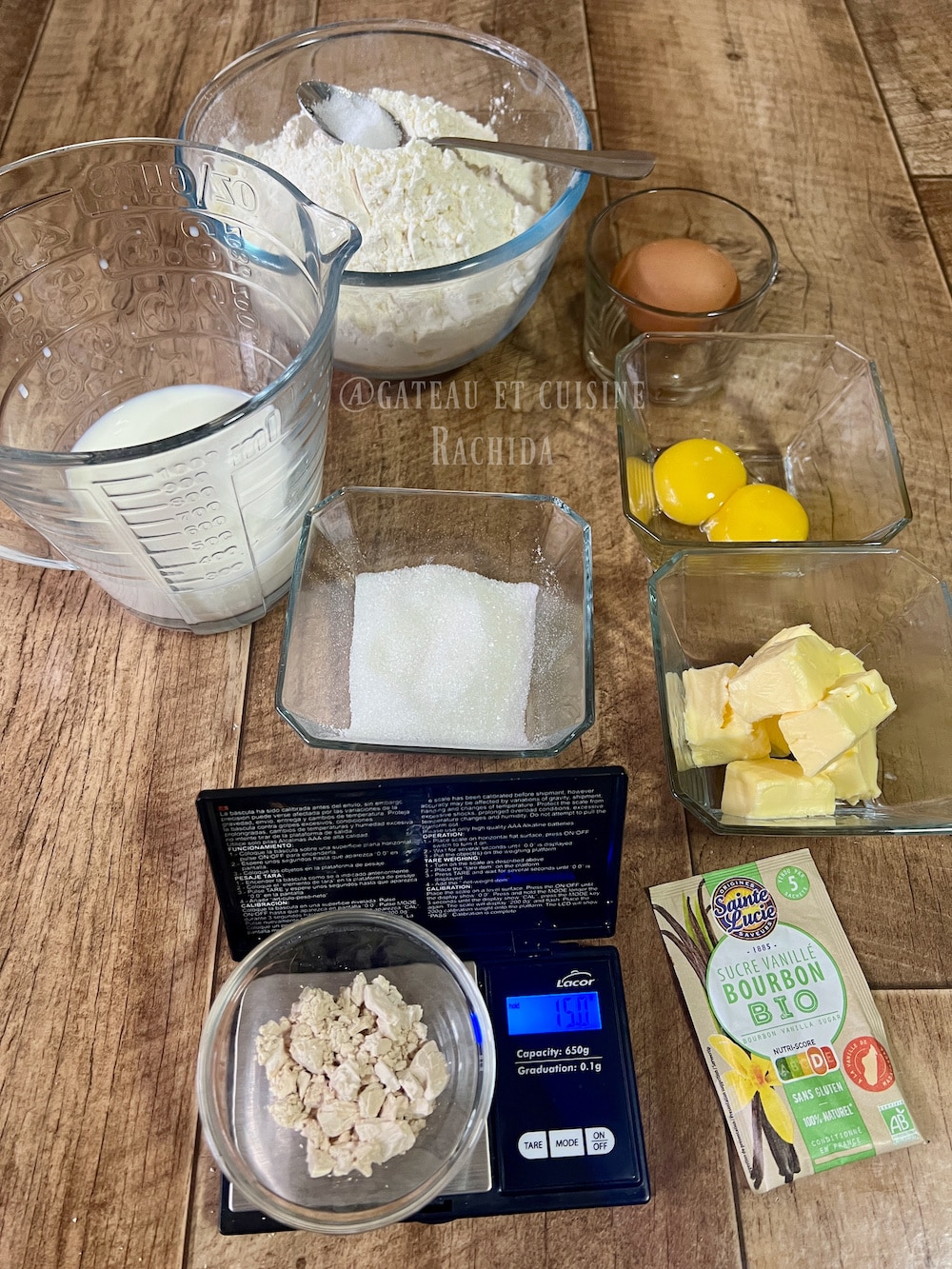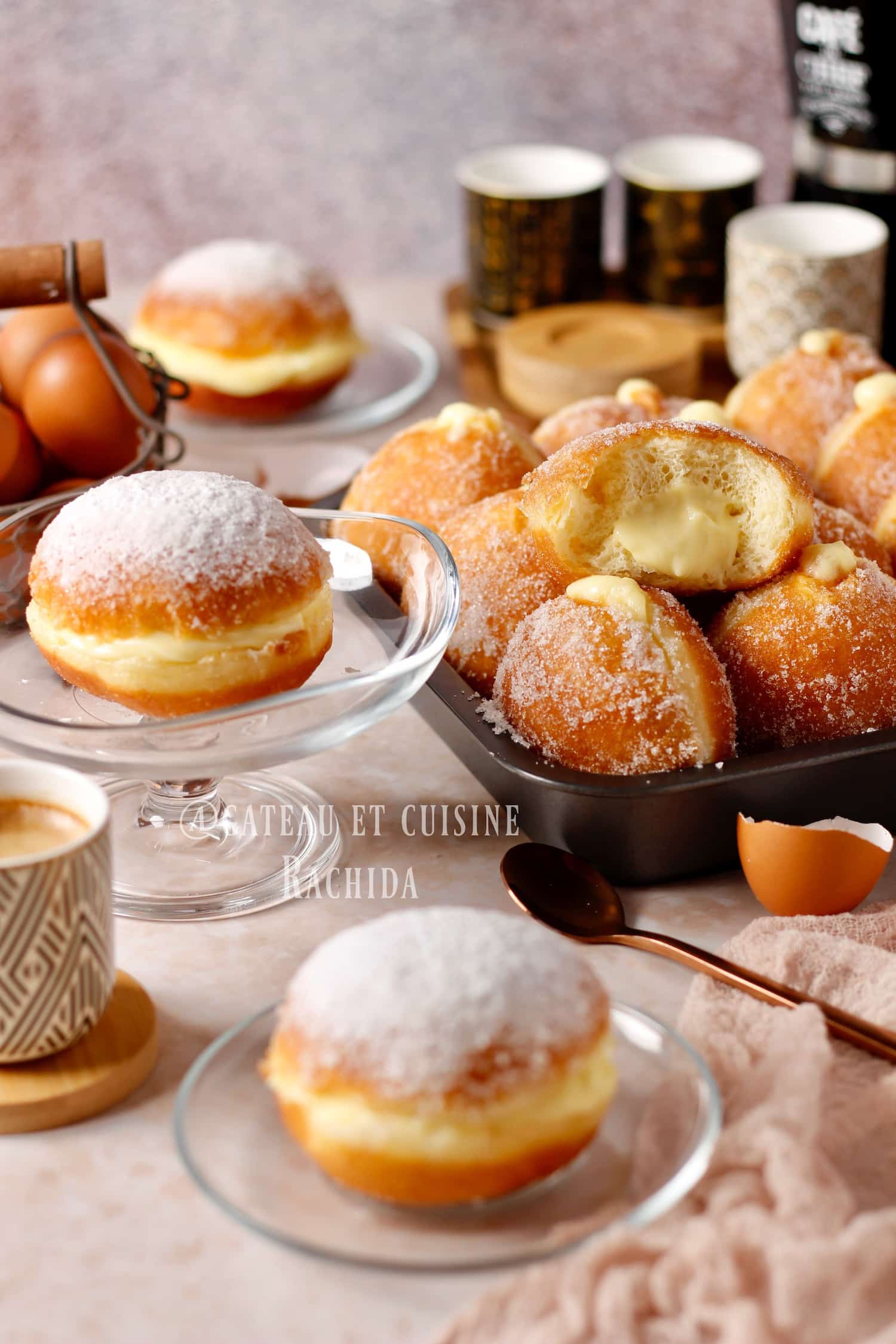
Traditional soft Berliner recipe
Berliner, Pfannkuchen or krapfen, are delicious, ultra-soft doughnuts of German origin, similar to Italian bombolini. Prepared with a brioche dough, they are filled with pastry cream or jam, fried, and then dusted with powdered sugar.
Traditionally associated with Carnival to celebrate Mardi Gras, these well-puffed doughnuts with an airy crumb can be enjoyed all year round. Very popular with children, they rival glazed doughnuts and Moroccan sfenj for snack time. Their success relies on good kneading and controlled frying. I’ll share all the tips for perfectly golden and airy donuts!
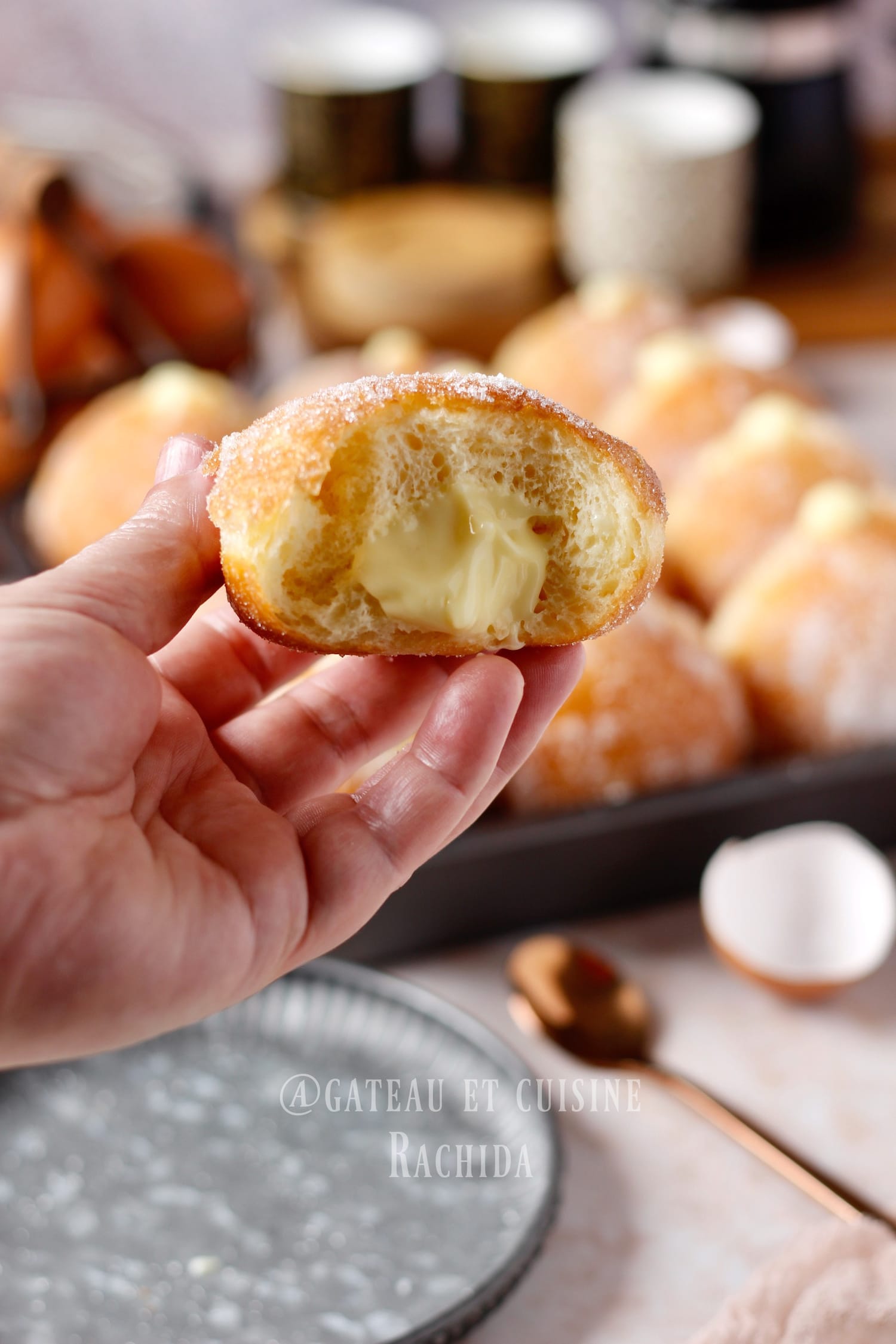
Table of Contents
Tips and tricks for successful German Berliner doughnuts
Ingredient Temperature: Make sure ingredients such as milk and eggs are at room temperature to promote good dough rising.
Kneading: Knead the dough sufficiently for about fifteen minutes to develop the gluten, which will give an airy and honeycomb-like crumb to the Berliner. You should obtain a smooth and elastic dough.
Proofing: It’s done in 2 stages. After kneading, shape the dough into a ball and let it rise in a warm place away from drafts until it doubles in volume. This can take about 1.5 to 2 hours. The proofing time may be longer or shorter depending on the room temperature and whether the milk is used cold or lukewarm.
Cover the bowl containing the dough tightly with plastic wrap and cover with a blanket in cold weather. After the first rise, deflate the dough then form small balls. Flatten them and let them rise until they double in volume (See the steps in images).
Shaping: When shaping the Berliner donuts, make sure to form smooth and uniform balls. Place them on squares of parchment paper to prevent them from losing their shape when transferring them into the hot oil. Remove the paper after 15 seconds, once it detaches easily. 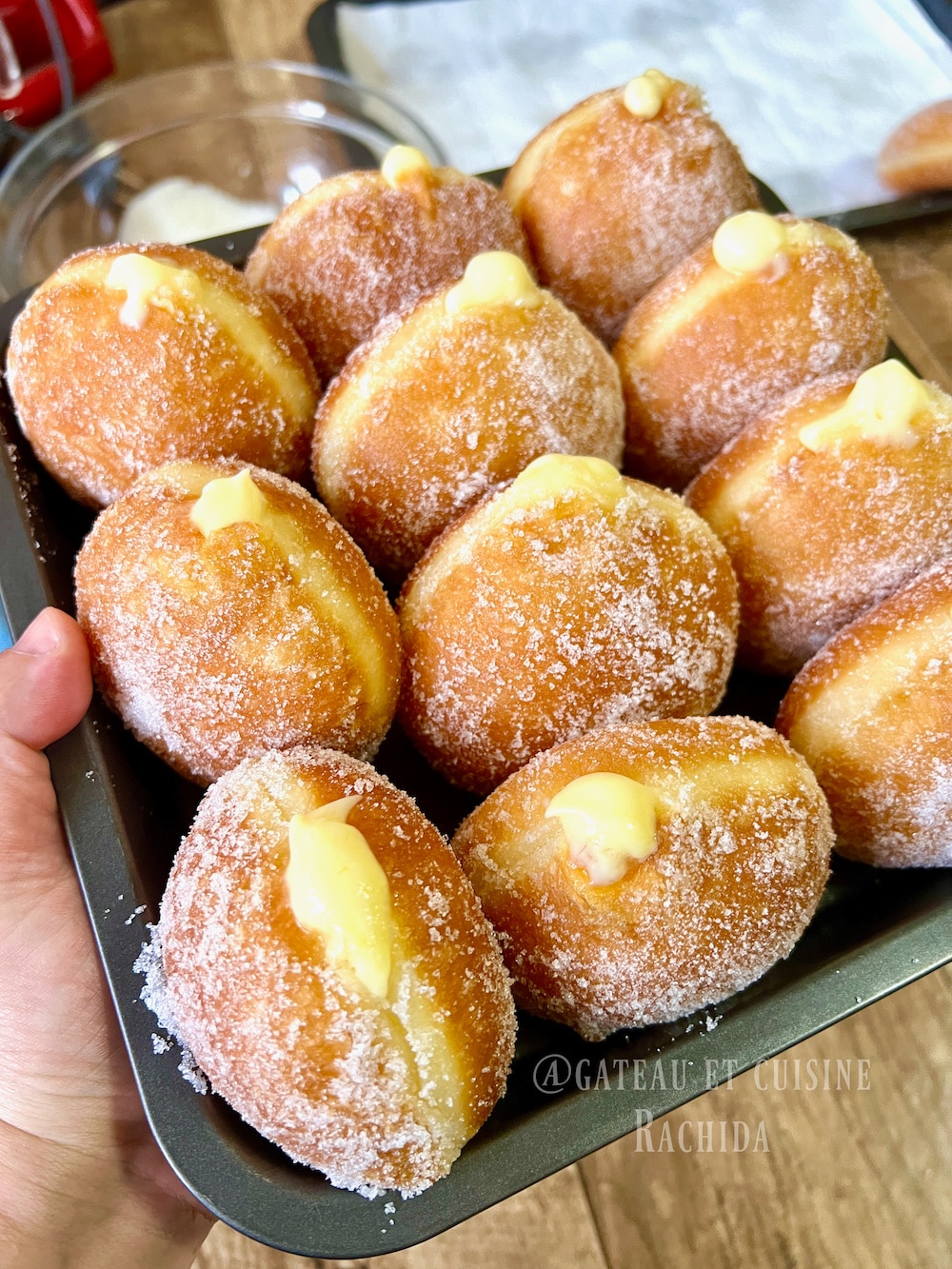
Control the thickness: Very important point that will define the internal texture of the doughnut. if you want plump Berlin balls with an airy crumb, form 60 g / 2 oz balls, then flatten them with the palm of your hand or a tartlet mold to 1 cm / 0.4 inches thickness to obtain 6 cm / 2.4 inches discs.
Take care to cover the ball with a square of parchment paper before flattening it, to prevent the dough from sticking to your hand or the mold. Press down once on all the formed balls, let them relax for 1 minute, as the dough retracts, then lower them again into 6 cm / 2.4 inches discs.
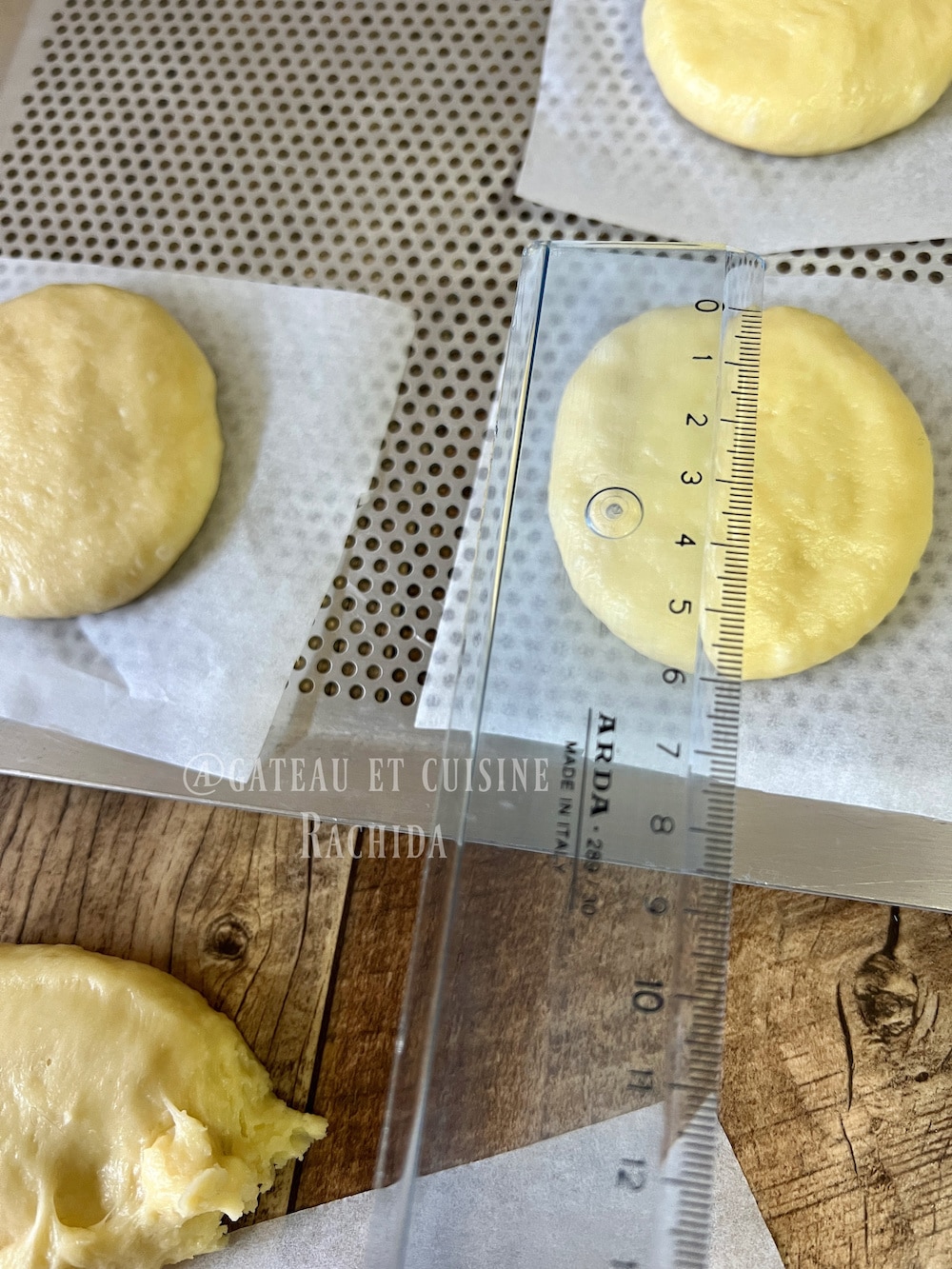
You can also choose to roll out all the dough to a thickness of 7 to 8 mm , then cut out discs using a cookie cutter of the size you want, about 7 to 8 cm, more or less. You will get doughnuts that are more hollow inside.
Cooking: The 2nd very important key point is to master the cooking of the Berliner doughnuts. The frying oil needs to be at the right temperature so that the doughnuts cook well on the inside while taking on a nice golden color. If the oil is not hot enough, they will soak up oil, and if the oil is too hot, they will brown quickly on the outside and the dough will remain raw inside.
If you have a thermometer or a deep fryer, it will help you control the right temperature. Heat the oil to 168°C/170°C ( 334°F / 338°F ) and lower the heat to very low to maintain a temperature that does not drop below 155°C ( 311°F) and does not exceed 170°C ( 338°F). If you don’t have a thermometer, check with the traditional method. Test by throwing a small piece of dough into the oil. If it rises to the surface, the oil is ready. The Berlin balls should cook evenly, browning slowly. Each side takes about 2 minutes to cook.
Glazing and filling: If you want to roll the doughnuts in granulated sugar, do it as you cook them when the doughnuts are still hot to make the sugar stick well. Fill with the filling of your choice when they are warm or cold to prevent the filling from leaking.
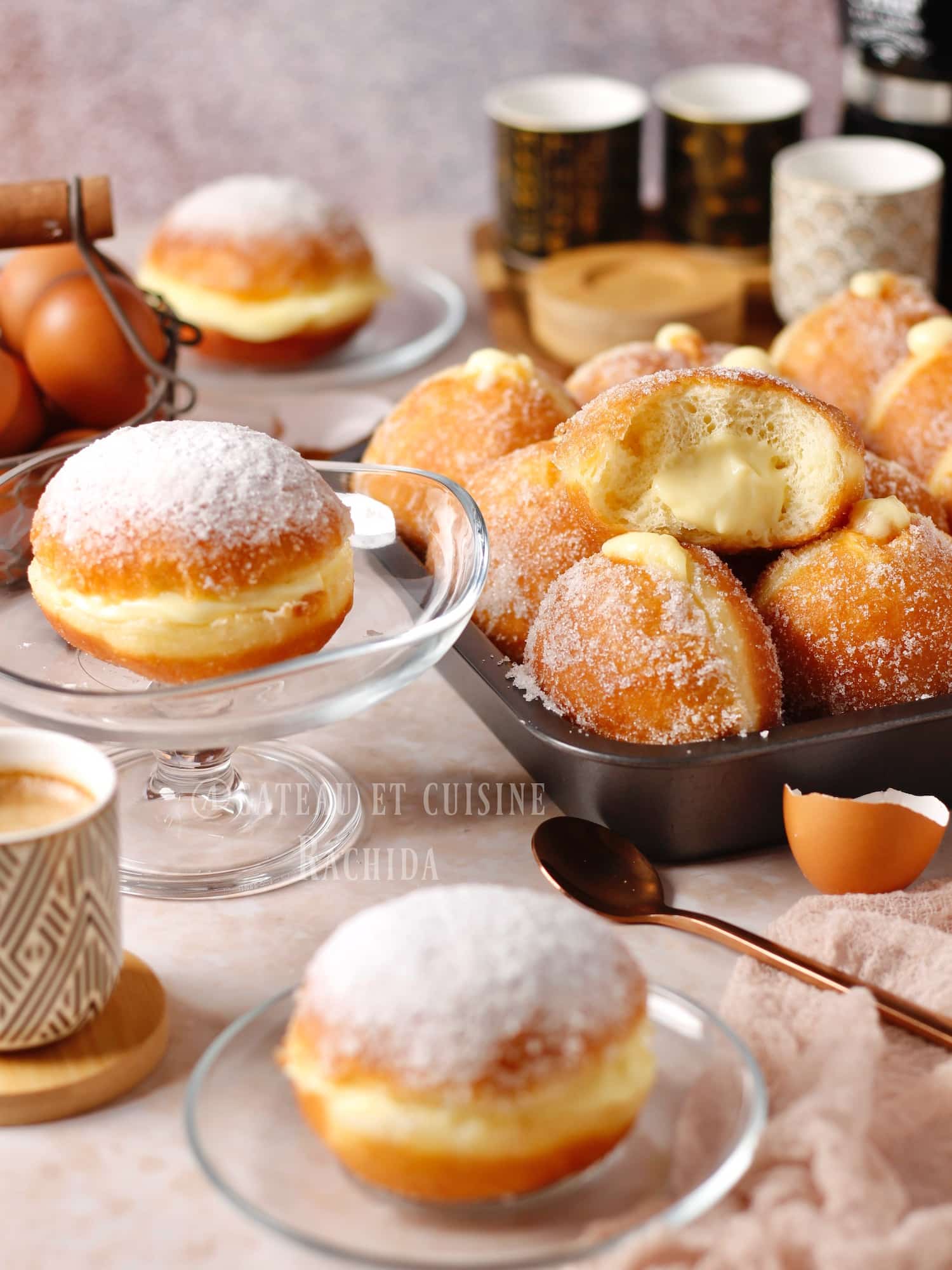
Preparation steps :
| NB: Find the complete recipe with detailed ingredient quantities in the recipe card at the end of the article, which you can also print out. Below are the instructions, which you can also view in images. |
The pastry cream filling
(you can prepare it the day before)
In a saucepan, heat the milk with a little sugar (taken from the total amount) over medium heat with the vanilla pod split in half and scraped (if using a pod) or vanilla sugar.
In a mixing bowl, whisk the egg yolks with the remaining sugar until the mixture becomes slightly pale.
Add the cornstarch and sifted flour. Mix to obtain a smooth batter without whisking too much.
When the milk is hot (without boiling ), gradually pour it over the egg mixture, stirring constantly to prevent the eggs from cooking.
If you used a vanilla pod, remove it.
Pour the mixture into the saucepan and put it back on the heat. Thicken over low heat while continuing to stir constantly with a whisk.
The cream will thicken gradually. Remove from heat when bubbles start to burst on the surface.
Off the heat, add the butter and whisk well until it is completely melted.
Spread the pastry cream in a fairly wide dish, cover with plastic wrap, and press the wrap onto the surface to prevent a crust from forming.
Place it in the refrigerator to cool.
Prepare the dough for the Berliner donuts
In the bowl of the stand mixer (like a KitchenAid), pour the salt then the sifted flour on top to prevent the salt from coming into contact with the yeast. Add the sugar, crumbled baker’s yeast, egg yolks and whole egg, and 3/4 of the milk.
Knead at speed 1 for 5 minutes while adding the rest of the milk to obtain a homogeneous dough. You may need to add more or less than 170 ml ( 6 oz )depending on the absorption of the flour. The dough should come away from the sides of the bowl and form a soft ball.
Add the butter in 3 parts while continuing to knead for an additional 5 minutes at speed 1. If the butter has difficulty incorporating into the dough, scrape the sides of the bowl and give 2 to 3 strokes with a dough cutter or your hand.
Continue kneading for another 5 minutes at speed 2 until the dough becomes smooth and elastic and wraps around the hook.
Turn it out onto the work surface and work it for 2 minutes to smooth it further. Form a smooth ball.
Place the ball of dough in a bowl and cover with plastic wrap. Cover with a clean cloth and possibly a blanket in cold weather.
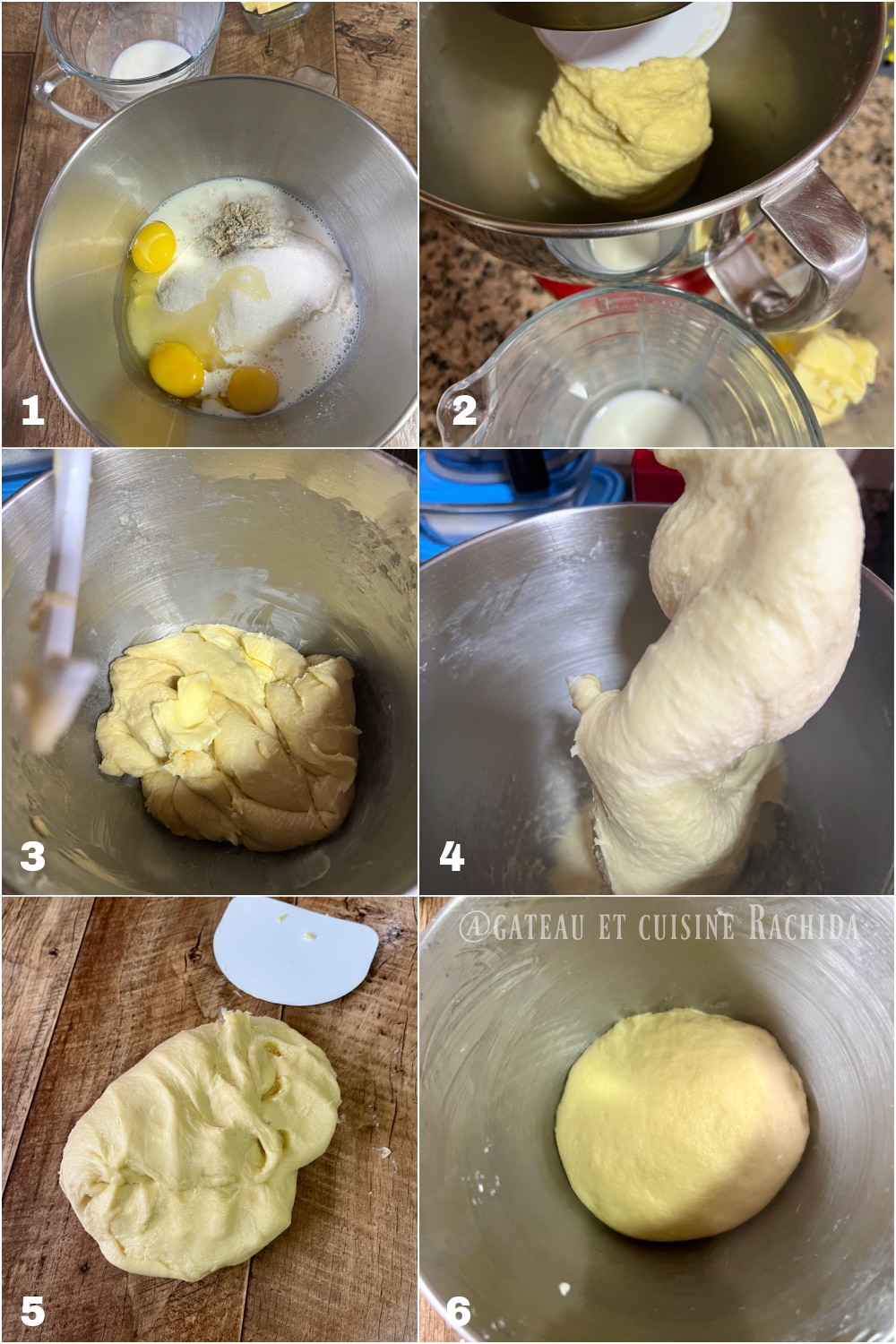
Let it rise in a warm place away from drafts until it doubles in volume. This can take 1.5 to 2 hours or more depending on the ambient temperature.
After this proofing time, deflate the dough by pressing on it with your hand to release the trapped air.
Turn it out onto the work surface and knead it briefly to form a long dough log.
Cut pieces of 60 g / 2 oz each with a dough cutter. You will get 15 balls.
Shape each piece of dough into a ball and place them on a small square of parchment paper or a lightly floured kitchen towel on top of a baking sheet.
I recommend the small squares of paper which are very convenient for moving the doughnuts without deforming them.
As you go, flatten the balls a first time with the palm of your hand or using the bottom of a tartlet mold. Before flattening, place a square of parchment paper on top to prevent the dough from sticking to your hand or the mold.
Wait 1 minute for the dough to relax as it tends to retract (a sign of good kneading that has activated the gluten) and flatten again to obtain discs of about 6 cm / 2.4 inches.
Cover with a clean cloth and let rise until they double in volume. This usually takes about 30 minutes from the last ball formed and flattened.
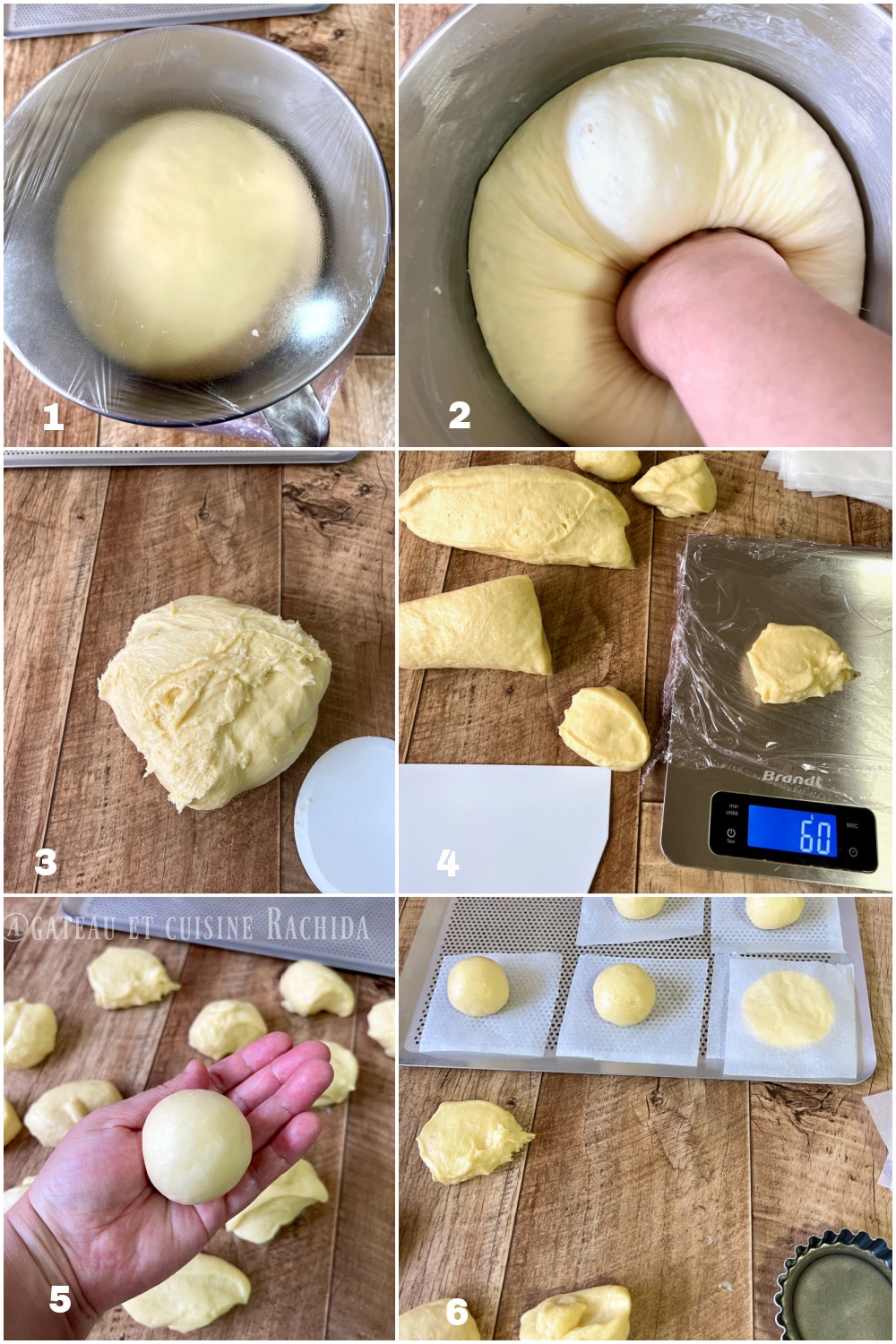
The cooking (frying):
Heat the oil to 170°C (338°F) in a large saucepan or Dutch oven (24 cm / 9.5 inches here).
Once the temperature is reached, lower the heat to low to maintain the temperature between 155°C and 170°C (311°F and 338°F).
Place the dough discs one after another in the oil. I put 4 at a time, no more to avoid cooling the oil.
Remove the pieces of paper as soon as they detach (15 seconds).
Cook slowly for about 2 minutes, until the bottom side has taken on a nice golden color, then turn them over.
Let the doughnut float and do not press it down to submerge it in the oil, otherwise you won’t get the white line surrounding the Berliner.
Brown the other side for 2 minutes and remove the balls using a skimmer or kitchen spider.
Place on a tray covered with paper towels and continue frying the rest of the doughnuts.
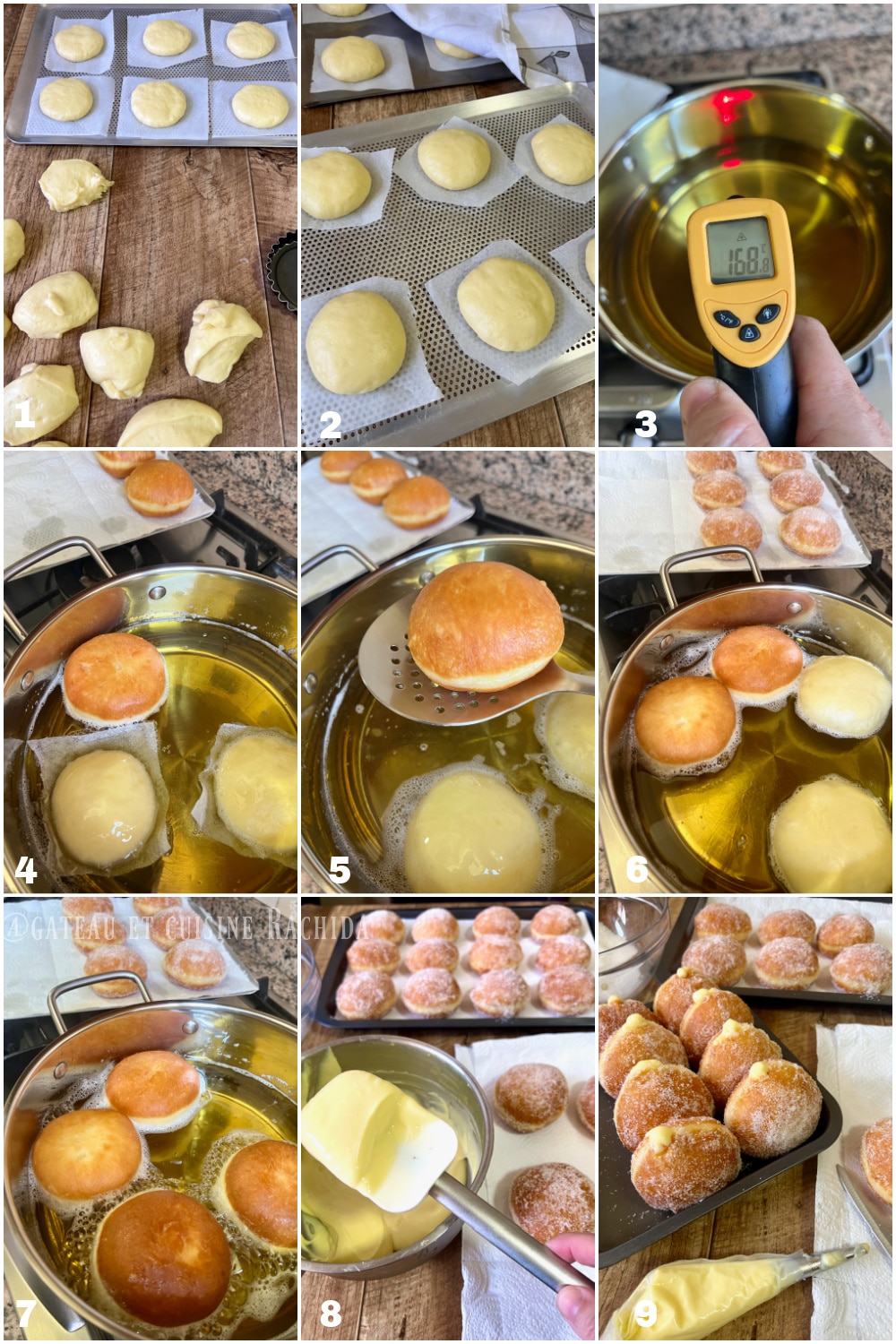
Roll in granulated sugar as you go while the doughnuts are still hot. The sugar will adhere better. If you plan to cut the doughnuts in half to generously fill them with pastry cream, you can skip this step.
Place on a tray and let them cool down or cool completely before filling.
Whisk the pastry cream well to smooth it out and put it in a piping bag with a special filling tip.
Make a small cut with a knife on the white band of the doughnut and fill with pastry cream or other filling of your choice, jam or spread.
You can also cut each Berliner in half and fill with pastry cream. In this case, use a fluted nozzle for a nice finish. Close the balls and generously dust with powdered sugar.
Arrange them on a serving platter and serve to enjoy.
Storage:
The Berliner doughnuts are delicious and stay nice and soft for 2 days when stored in an airtight container at room temperature but without the pastry cream. You can prepare a large quantity and freeze them after forming the dough discs after the first rise.
On the day you want to cook them, take out the quantity you want and let them thaw at room temperature then double in volume (2nd rise) before frying them.
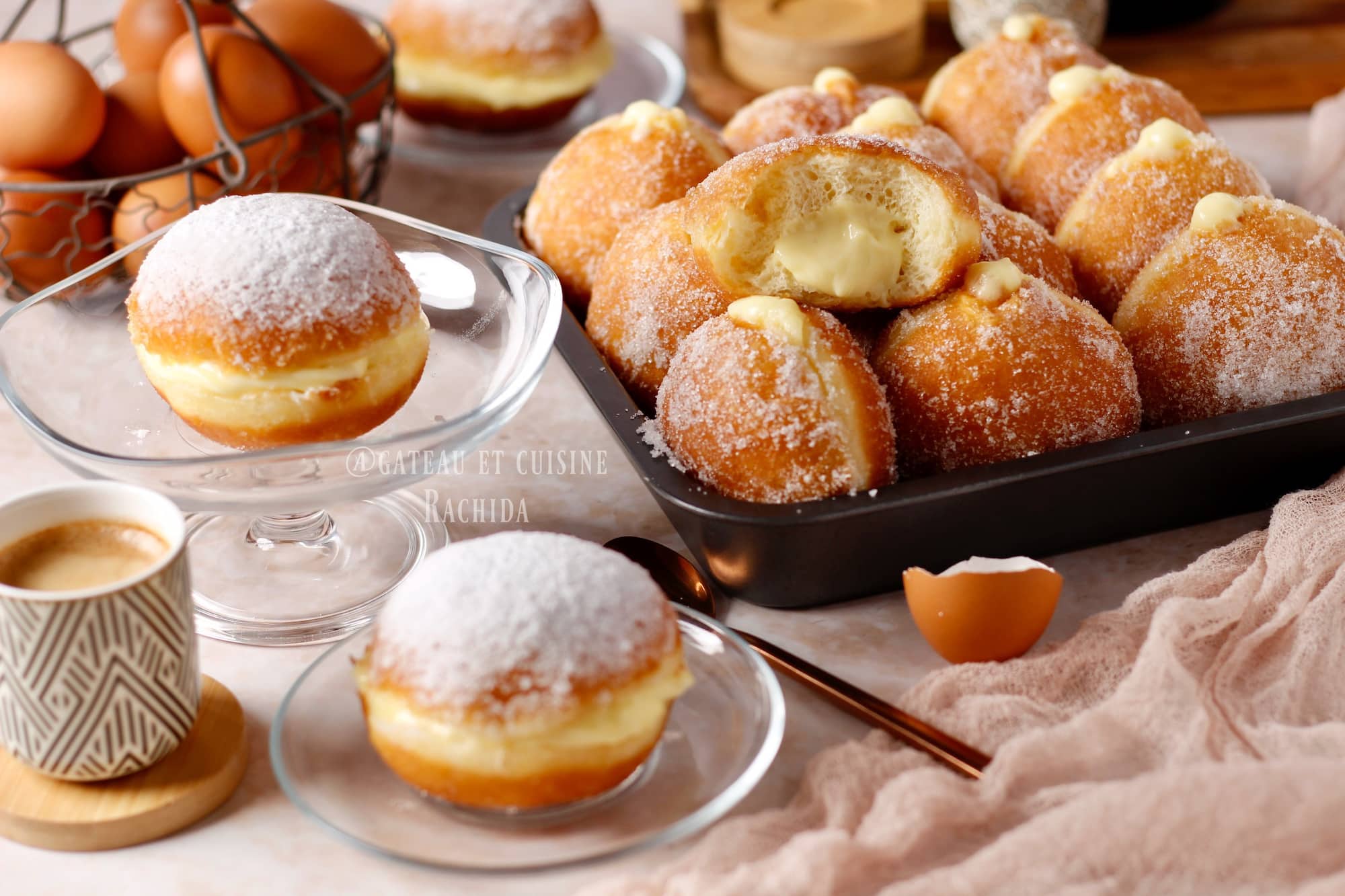
Suggestions for other snack recipes
Soft French Bugnes (New Orleans-Style Beignets )
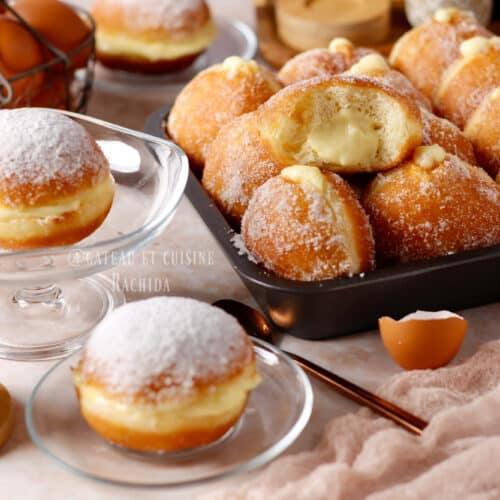
Berliner German Filled doughnuts
INGREDIENTS
For the Berliner Dough:
- 500 g all-purpose flour
- 65 g granulated sugar
- 170 ml milk adjust according to dough absorption
- 15 g fresh baker's yeast (or 8 g / 0.28 oz dry baker's yeast)
- 2 egg yolks + 1 whole egg 96 g / 3.4 oz total without shells
- 80 g soft butter
- 1/2 teaspoon salt
For Frying:
- 1 to 1.2 liters vegetable oil
For the Pastry Cream Filling:
- If you want to cut the Berliners in half and fill them generously, double the quantity below. I only filled three and injected the rest.
- 250 ml whole milk
- 60 g granulated sugar
- 50 g egg yolk 2 yolks
- 15 g cornstarch
- 15 g all-purpose flour
- 25 g butter
- Seeds from one vanilla bean or vanilla extract or one packet of vanilla sugar
PREPARATION
The pastry cream filling
- (you can prepare it the day before)
- In a saucepan, heat the milk with a little sugar (taken from the total amount) over medium heat with the vanilla pod split in half and scraped (if using a pod) or vanilla sugar.
- In a mixing bowl, whisk the egg yolks with the remaining sugar until the mixture becomes slightly pale.
- Add the cornstarch and sifted flour. Mix to obtain a smooth batter without whisking too much.
- When the milk is hot (without boiling ), gradually pour it over the egg mixture, stirring constantly to prevent the eggs from cooking.
- If you used a vanilla pod, remove it.
- Pour the mixture into the saucepan and put it back on the heat. Thicken over low heat while continuing to stir constantly with a whisk.
- The cream will thicken gradually. Remove from heat when bubbles start to burst on the surface.
- Off the heat, add the butter and whisk well until it is completely melted.
- Spread the pastry cream in a fairly wide dish, cover with plastic wrap, and press the wrap onto the surface to prevent a crust from forming.
- Place it in the refrigerator to cool.
Prepare the dough for the Berliner donuts
- In the bowl of the stand mixer (like a KitchenAid), pour the salt then the sifted flour on top to prevent the salt from coming into contact with the yeast. Add the sugar, crumbled baker's yeast, egg yolks and whole egg, and 3/4 of the milk.
- Knead at speed 1 for 5 minutes while adding the rest of the milk to obtain a homogeneous dough. You may need to add more or less than 170 ml ( 6 oz )depending on the absorption of the flour. The dough should come away from the sides of the bowl and form a soft ball.
- Add the butter in 3 parts while continuing to knead for an additional 5 minutes at speed 1. If the butter has difficulty incorporating into the dough, scrape the sides of the bowl and give 2 to 3 strokes with a dough cutter or your hand.
- Continue kneading for another 5 minutes at speed 2 until the dough becomes smooth and elastic and wraps around the hook.
- Turn it out onto the work surface and work it for 2 minutes to smooth it further. Form a smooth ball.
- Place the ball of dough in a bowl and cover with plastic wrap. Cover with a clean cloth and possibly a blanket in cold weather.
- Let it rise in a warm place away from drafts until it doubles in volume. This can take 1.5 to 2 hours or more depending on the ambient temperature.
- After this proofing time, deflate the dough by pressing on it with your hand to release the trapped air.
- Turn it out onto the work surface and knead it briefly to form a long dough log.
- Cut pieces of 60 g / 2 oz each with a dough cutter. You will get 15 balls.
- Shape each piece of dough into a ball and place them on a small square of parchment paper or a lightly floured kitchen towel on top of a baking sheet.
- I recommend the small squares of paper which are very convenient for moving the doughnuts without deforming them.
- As you go, flatten the balls a first time with the palm of your hand or using the bottom of a tartlet mold. Before flattening, place a square of parchment paper on top to prevent the dough from sticking to your hand or the mold.
- Wait 1 minute for the dough to relax as it tends to retract (a sign of good kneading that has activated the gluten) and flatten again to obtain discs of about 6 cm / 2.4 inches.
- Cover with a clean cloth and let rise until they double in volume. This usually takes about 30 minutes from the last ball formed and flattened.
The cooking (frying):
- Heat the oil to 170°C (338°F) in a large saucepan or Dutch oven (24 cm / 9.5 inches here). Once the temperature is reached, lower the heat to low to maintain the temperature between 155°C and 170°C (311°F and 338°F).Place the dough discs one after another in the oil. I put 4 at a time, no more to avoid cooling the oil.
- Remove the pieces of paper as soon as they detach (15 seconds).
- Cook slowly for about 2 minutes, until the bottom side has taken on a nice golden color, then turn them over.
- Let the doughnut float and do not press it down to submerge it in the oil, otherwise you won't get the white line surrounding the Berliner.
- Brown the other side for 2 minutes and remove the balls using a skimmer or kitchen spider.
- Place on a tray covered with paper towels and continue frying the rest of the doughnuts.
- Roll in granulated sugar as you go while the doughnuts are still hot. The sugar will adhere better. If you plan to cut the doughnuts in half to generously fill them with pastry cream, you can skip this step.
- Place on a tray and let them cool down or cool completely before filling.
- Whisk the pastry cream well to smooth it out and put it in a piping bag with a special filling tip.
- Make a small cut with a knife on the white band of the doughnut and fill with pastry cream or other filling of your choice, jam or spread.
- You can also cut each Berliner in half and fill with pastry cream. In this case, use a fluted nozzle for a nice finish. Close the balls and generously dust with powdered sugar.
- Arrange them on a serving platter and serve to enjoy.
Thank you for visiting my blog and for your comments.
You can also follow me on my youtube channel

